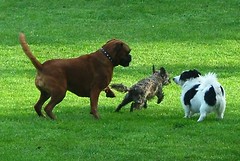 Any owner of multiple dogs can tell you that each dog has a unique personality and removing a dog, or adding a new one, can significantly alter the dynamics of the group. Last December, I added a new dog, Sara, to our pack (she makes 3). I’ve been watching the dynamic of my group of dogs change ever since. To successfully add a new dog to your family pack requires training and management of certain situations until the new group dynamic has been established.
Any owner of multiple dogs can tell you that each dog has a unique personality and removing a dog, or adding a new one, can significantly alter the dynamics of the group. Last December, I added a new dog, Sara, to our pack (she makes 3). I’ve been watching the dynamic of my group of dogs change ever since. To successfully add a new dog to your family pack requires training and management of certain situations until the new group dynamic has been established.
Making the jump from 2 dogs to 3 was easier for me than the jump from a single dog to 2 dogs, partly because my boys, Barret and Gatsby, were already past the adolescent stage and partly because I’d learned some hard lessons when I brought Gatsby home from the shelter. The decision to add a second or third dog to your family isn’t one that should be taken lightly. While animals in the shelter can be tempting, take the time to decide if you can properly care for your new animal and consider the personalities of your existing pets to decide if they would benefit from a new companion.
 New pets, especially puppies, although a joy to experience, can be financially draining and time consuming. Consider the added costs of annual vet visits and vaccinations. Also consider what you will have to spend on the additional toys, treats, and food. Once you’ve decided that you have the time and finances to add a new pet, start searching for your new addition. Keep in mind that like-tempered animals will be more successful together (choose an energetic dog if you already have an energetic dog, or a laid back dog if you have a couch potato on your hands).
New pets, especially puppies, although a joy to experience, can be financially draining and time consuming. Consider the added costs of annual vet visits and vaccinations. Also consider what you will have to spend on the additional toys, treats, and food. Once you’ve decided that you have the time and finances to add a new pet, start searching for your new addition. Keep in mind that like-tempered animals will be more successful together (choose an energetic dog if you already have an energetic dog, or a laid back dog if you have a couch potato on your hands).
Training is Essential
Before you add a new dog to your pack, make sure that your existing dogs have basic obedience down pat. Establish yourself as the “pack leader”, with positive reinforcement and guidance. By establishing yourself as their leader, the likelihood of your established dogs ganging up on the new addition is less likely.
The Meeting
 The first lesson that I learned when adding a new dog to my pack is to have them meet for the first time on neutral territory. If you introduce your new dog inside your home, your existing dog may become territorial. Meet at a friend’s house or a local park, and after they have been properly introduced, you can bring them home.
The first lesson that I learned when adding a new dog to my pack is to have them meet for the first time on neutral territory. If you introduce your new dog inside your home, your existing dog may become territorial. Meet at a friend’s house or a local park, and after they have been properly introduced, you can bring them home.
It may take some time for your dogs to establish a pecking order. You shouldn’t have to get involved in their squabbles unless they become serious. The less dominant dog should back down and defer to the more dominant one. As pack leader, it is your responsibility to uphold this order. It is easy to give the new addition more attention and privileges if you aren’t consciously thinking about it. The dominant dog should be fed first, let out of the house first, etc. If you aren’t consistent about upholding the order of the pack, your dominant dog could become insecure, leading to other behavioral issues inside and outside of the home. This is exactly what happened to me: Barret became insecure and very anxious a few months after Sara came home. It took a visit to my vet to determine the underlying cause of his anxiety. He’s doing much better now that I accepted that he is the dominant dog in my pack and treat him as such. Until your dogs have established their order it is best that they only be allowed to interact while supervised.
Bad (and Sometimes Good) Influences
 Any bad habits that your dog may have can (and probably will) be learned by the new dog, and vice versa. Barking is a big example of this phenomenon. If you have a dog who barks incessantly at people or other dogs, the chances are that your new dog will learn and mimic this behavior. It is always a good idea to try to work out any behavioral issues your dog(s) have before adding a new pup to the mix, or risk compounding the issue.
Any bad habits that your dog may have can (and probably will) be learned by the new dog, and vice versa. Barking is a big example of this phenomenon. If you have a dog who barks incessantly at people or other dogs, the chances are that your new dog will learn and mimic this behavior. It is always a good idea to try to work out any behavioral issues your dog(s) have before adding a new pup to the mix, or risk compounding the issue.
On the other hand, I found that my established dogs were good influences on the newcomer. Potty-training Gatbsy was a lot less stressful because he seemed to take cues from Barret. He also seemed to take to obedience training faster. I might be anthropomorphizing here; he might have just a smart pup, but judging by his dietary indiscretions, I’m not so certain!
Play Referee
From time to time, there may be instances where you will have to step in and correct some behaviors, especially if you have added a puppy to the mix. If things get too rowdy, or if one dog is getting picked on, separate everyone until they’ve calmed down.
Only you and your family know if adding a new pet to your family is the right thing to do. Think long and hard, and follow your gut. It can be disappointing, but sometimes it is for the best to stay a single-dog family. You and your pet will be happiest if you do what you truly feel is the right thing. If you decide it is right for your family to be a multi-pet household I hope that you enjoy watching your pack grow and learn as I have enjoyed watching mine.
 That Pet Blog That Pet Place Pet Blog
That Pet Blog That Pet Place Pet Blog
